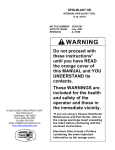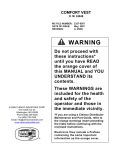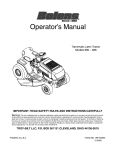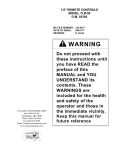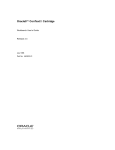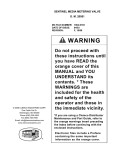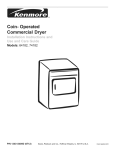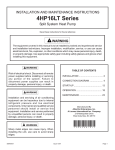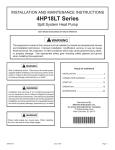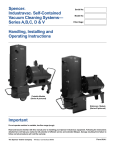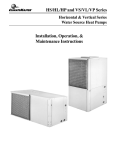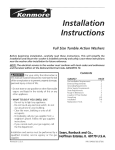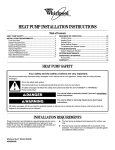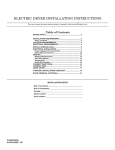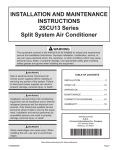Download a important
Transcript
INSTALLATION INSTRUCTIONS ® ';_)2007 Lennox Dallas, industries Texas, Jnc, USA HP13 Series Units HEAT PUMP UNITS 505,076M 06107 Supersedes 07/06 0( us RETAIN THESE INSTRUCTIONS FOR FUTURE REFERENCE WARNING A IMPORTANT X_ IMPORTANT LLJJ Publications Litho U.S.A. HP13 Outdoor Unit ............................ 1 Shipping & Packing List ........................ General Information ........................... 1 3 Unit Dimensions ............................... 2 Setting the Unit ............................... 3 Removing Panels ............................. Electrical ..................................... 5 6 Refrigerant Piping ............................. 8 Refrigerant Metering Device A CAUTION _Technical .................... 10 Manifold Gauge Set ........................... Service Valves ................................ 10 11 Leak Testing .................................. Evacuation ................................... 11 12 Start-Up ...................................... 12 Refrigerant Charging ........................... System Operation ............................. 13 15 Defrost System ............................... Maintenance .................................. 15 16 Optional Accessories .......................... Homeowner Information ........................ 16 17 Thermostat Operation .......................... 17 Start-Up and Performance Check List ............ 18 Lennox Elite ® Series HP13 outdoor units are approved and warranted only for installation with specially matched indoor coils, line sets, and refrigerant control devices aC designated by Lennox. Refer to Lennox engineering handbook for check expansion valve (CTXV) kits which may need to be ordered separately. 1 - Assembled HP13 outdoor unit Check unit for shipping damage. immediately if damage is found. 06/07 IIIlllllllllllllllllllllllllllllllllllll Page 1 Consult last carrier 505,076M IIIllllllllllllllllllllllllllll RUN CAPACITOR DEFROST BOARD ,OUTDOOR FAN CONTACTOR -COMPRESSOR REVERSING VALVE SUCTION LINE CONNECTION HIGH PRESSURE SWITCH (-018 MODEL ONLY) FILTER DRIER/ , VAPOR LINE LIQUID LINE CONNECTIONS LIQUID LINE CONNECTION TOP VIEW VAPOR VALVE AND - GAUGE PORT/SUCTION LINE CONNECTIONS HP13 PARTS ARRANGEMENT 4 q C t AIR DISCHARGE LIQUID LINE CONNECTION f-/ 'X/ / ELECTRICAL INLETS A J VAPOR LINE JCONNECTION - 2(51) I I SIDE VIEW 4-1/4 (108) 4-3/4 (121) f f [_N I I UNIT SUPPORT FEET \ 8-1/2 (2" 9-1/2 8-3/4 8-1/4 (210) (2 / D 41) i SIDE VIEW 1 (25) UNIT SUPPORT FEET i "_ (_ @ C) K _l E J l l -r ----I- (343) HP13-018, -024, -030, AND BASE SECTIONS HP13 A B C -018 35 (889) 27 (686) 28 (711) -024 -030 35 (889) 27 (686) 28 (711) 31 (787) 27 (686) 28 (711) -036 35 (889) 27 (686) 28 (711) -042 35 (889) 30-1/2 (775) 35 (889) -048 -060 39 (991) 30-1/2 (775) 35 (889) 39 (991) 35-1/2 (902) 39-1/2 HP13 BASE WITH ELONGATED LEGS -036 (1003) D E 06/07 G H J K 13-7/8 (352) 7-3/4 (197) 3-1/4 (83) 27-1/8 (689) 3-5/8 (92) 4-1/2 (114) 20-5/8 (524) 16-7/8 (429) 8-3/4 (222) 3-1/8 30-3/4 (781) 4-5/8 (117) 3-3/4 (95) 26-7/8 (683) Page 2 505076M F (79) position that will transmit sound or vibration to the living area or adjacent buildings. 2+ Install the unit high enough above ground or roof to allow adequate drainage of defrost water and prevent ice build-up. 3+ In heavy snow areas, do not locate unit the where snowdrifts will likely build. The unit base should be elevated above the depth of average snows. NOTE - Elevation of the unit may be accomplished by constructing a frame using suitable materials. If a support frame is constructed, it must not block drain holes in unit base. WARNING 4+ Locate the unit so prevailing winter winds will not blow into the coil. 5. Locate unit away from overhanging roof lines which would allow water or ice to drop on, or in front of, coil or into unit. These instructions are intended as a general guide and do not supersede national or local codes in any way. Authorities having jurisdiction should be consulted before installation+ When servicing or repairing HVAC components, ensure the fasteners are appropriately tightened. Table 1 shows torque values for fasteners+ Table 1. Torque Requirements Parts Recommended Torque Service valve cap 8 ft.- lb. 11 NM Sheet metal screws 16 in.- lb. 2 NM NOTES: Machine screws #10 28 in.- lb. 3 NM Compressor bolts 90 in.- lb. 10 NM Service clearance of 30 in. (762 mm) must be maintained on one of the sides adjacent to the control box+ Gauge port seal cap 8 ft.- lb. 11 NM Clearance to one of the otherthree sides must be 36 in. (914 mm) Clearance to one of the remaining two sides may be 12 in+(305 mm) and the final side may be 6 in. (152 mm), A clearance of 24 in, (610 mm) must be maintained between two units. CAUTION 48 in. (1219 mm) clearance required on top of unit, Figure SLAB Outdoor units operate under a wide range of weather conditions; therefore, several factors must be considered when positioning the outdoor unit+ 1. Installation Clearances MOUNTING Position the unit to allow adequate airflow and servicing clearance. Maintain a minimum clearance of 24 inches (610 mm) between multiple units as illustrated in figure 1+ When installing unit at grade level, the top of the slab should be high enough above grade so that water from higher ground will not collect around the unit. The slab should have a slope tolerance away from the building of 2 degrees or 2 inches per 5 feet (50 mm per 1500 mm) to prevent ice build-up under the unit during a defrost cycle+ 1+ Place a sound-absorbing material, such as Isomode, under the unit if it will be installed in a location or NOTE - If necessary for stability, anchor unit to slab as described in "Stabilizing unit on uneven surfaces". Page 3 HP13 SERIES ELEVATING THE UNIT (LARGER-BASE UNITS) Unlike the small-base units which use round feet, the larger-base units are outfitted with elongated feet as illustrated in figure 4. which uses a similar method for elevating the unit height. INSTALL UNIT LEVEL OR, IFON ASLOPE, MAINTAIN SLOPE TOLERANCE OF 2 DEGREES (OR 2 INCHES PER 5FEET [50 MM PER 1.5 M]) AWAY FROM BUILDING STRUCTURE. __L BUILDING STRUCTURE MOUNTING SLAB GROUND _ i If additional elevation is necessary, raise the unit by extending the length of the unit support feet. This may be done with 2" SCH 40 female threaded adapter. The specified coupling will fit snuggly into the recess portion of the feet. Additional couplers can be used to make additional adjustments to the level of the unit. T NOTE - Keep the height of extenders short enough to ensure a sturdy installation. If it is necessary to extend further, consider a different type of field-fabricated framework that is sturdy enough for greater heights. LEVEL Figure 2. Slab Mounting Options ELEVATING THE UNIT (SMALL-BASE UNITS) Base If additional elevation is necessary, raise the unit by extending the length of the unit support feet. This may be done by cutting four equal true-cut lengths of Schedule (SCH) 40, 4" (101.6mm) piping to the height required as illustrated in figure 3. NOTE - Keep the height of extenders short enough to ensure a sturdy installation. If it is necessary to extend further, consider a different type of field-fabricated framework that is sturdy enough for greater heights. The inside diameter of the 4" (101.6mm) piping is approximately 0.25" (6.35mm) greater than the pre-installed feet on the unit. Devise a shim that will take up the space and hold the extenders onto the feet during this procedure. Small strips of 0.125" (3.175mm) thick adhesive foam may be used. One or two small 1" (25.4mm) square strips should be adequate to hold the extender in place. Leg Detail 2" (50.8ram) SCH 40 Female Threaded Adapter Figure 4. Elevated Slab Mounting using Feet Extenders (Larger-Base Units) Base STABILIZING UNIT ON UNEVEN SURFACES To help stabilize an outdoor unit, some installations may require strapping the unit to the pad using brackets and anchors commonly available in the marketplace. TYPICAL INSTALLATION WITH 3 TO 4 IN. EXTENDERS IMPORTANT! INSTALLED _ ALWAYS USE STABILIZER BRACKET ON ELEVATED INSTALLATIONS Leg Detail 4" (101.6mm) __,,,t STRUCTURE BUILDING MOUNTING _ SLAB i T STABILIZER BRACKETS SCH 40 Piping GROUNDLEVEL Figure 5. Elevated Slab Mounting using Feet Extenders Figure 3. Elevated Slab Mounting using Feet Extenders (Small-Base Units) Page 4 505076M 06/07 IMPORTANT prevailing winter winds wind barrier ] 24" _641'0 ram) inlet air ,_ inlet air inlet a[_ With unit Iouvered brackets practices; positioned at installation site, remove two side panels to expose the unit base pan. Install the as illustrated in figure 6 using conventional replace the panels after installation is complete. O inlet air Figure 7. Rooftop Application with Wind Barrier If unit cannot be located away from prevailing winter winds, construct a wind barrier sized at least the same height and width as outdoor unit. Position barrier 24" (610 mm) from the sides of the unit in direction of prevailing winds (fig. 7). Slab Side Mounting IMPORTANT! Do not allow panels to hang on unit by top tab. Tab is for alignment and not designed to support weight of panel, Panel shown slightly rotated to allow top tab to exit (or enter) top slot for removing (or installing) panel. LIP SCREW HOLES Detail ONE BRACKET PER SIDE (MIN.); FOR EXTRA STABILITY, 2 BRACKETS PER SIDE, 2" FROM EACH CORNER. Figure 6. Installing J Stabilizer Brackets ROTATE IN THIS DIRECTION; THEN DOWN TO REMOVE PANEL ROOF MOUNTING Install unit 6" (152 mm) above the roof surface to avoid ice build-up around the unit. Locate the unit above a load bearing wall or area of the roof that can adequately support the unit, Consult local codes for rooftop applications. If unit cannot be located away from prevailing winter winds, construct a wind barrier sized at least the same height and width as outdoor unit, Position barrier 24" (610 mm) from the sides of the unit in direction of prevailing winds as illustrated in figure 7, Figure 8. Removing/Installing Louvered Panels (Details A, B and C) Remove the Iouvered panels as follows: 1, Remove 2 screws, allowing the panel to swing open slightly (see figure 8). 2. Hold the panel firmly throughout this procedure. Rotate bottom corner of panel away from hinge corner post until lower 3 tabs clear the slots (see figure 8, Detail B), Page 5 HP13 SERIES DEFROST CONTROL DUAL CAPACITOR CAPACITOR START UTDOOR ,j! o FAN PURPLE BLACK ORANGE RED + BLACK LLOW --C --L COMPRESSOR o_- --R © --0 Y1ou_ CRANKCASE --YI HEATER POTENTIAL _M_SOR (_ CONTACTOR I / I /k DEFROST.ff'"x _'\,REVERSING THERMOSTAT_ *MAY BE OPTIONAL 20B-230/60/I EQUIPMENT GROUND _VALVE T Figure 9. Typical Field Wiring 3. Move panel down until lip of upper tab clears the top slot in corner post (see figure 8, Detail A). Diagram MAINTAIN MINIMUM PANEL ANGLE (AS CLOSE TOPARALLEL WITH THEUNIT AS POSSIBLE) WHILE INSTALLING PANEL. HOLD DOOR ANGLE CAUTION MAY BE TOO EXTREME PREFERRED _-_ FIRMLY TO THE HINGED SIDE TO MAINTAIN FULLY-ENGAGED TABS ANGLE Detail D Position and Install Panel--Position the panel almost parallel with the unit (figure 8, Detail D) with the "screw side" as close to the unit as possible, Then, in a continuous motion: • Slightly rotate and guide the lip of top tab inward (figure 8, Details A and C); then upward into the top slot of the hinge corner post, • Rotate panel to vertical to fully engage all tabs, • Holding the panel's hinged side firmly in place, close the right-hand side of the panel, aligning the screw holes. When panel is correctly positioned and aligned, insert the screws and tighten, Figure 10. Removing/Installing Panels (Detail D) In the U.S.A., wiring must conform with current local codes and the current National Electric Code (NEC). In Canada, wiring must conform with current local codes and the current Canadian Electrical Code (CEC). Refer to the furnace or blower coil installation instructions for additional wiring application diagrams and refer to unit nameplate for minimum circuit ampacity and maximum overcurrent protection size. Page 6 505076M 06/07 Louvered 4, Install low voltage wiring from outdoor to indoor unit and from thermostat to indoor unit, See figures 11 and 12, _WARNING Thermostat Indoor Unit 24V Power . * a-ux_ry ® © _ x_arTh_-- @ _ 4 i1st-stage Outdoor Unit __ 24V j_ower _ common II -I_'- _ heat __ 1st-stage I k ,@ ® ._doorb,owor _ reversing _ 1, Install line voltage power supply to unit from a properly sized disconnect switch, compressor (SOME CONNECTIONS MAY NOT APPLY. REFER TO SPECIFIC THERMOSTAT AND INDOOR UNIT.) 2, Ground unit at unit disconnect switch or to an earth ground, NOTE - To facilitate conduit, a hole is in the bottom of the control box. Connect conduit to the control box using a proper conduit fitting. valve Figure 11. Outdoor Unit and Blower Unit Thermostat Designations Thermostat NO TE - Units are approved for use only with copper conductors. 24V, Class II circuit connections are made in the low voltage junction box. Refer to figure 9 for field wiring diagram. ®©- Indoor Unit Outdoor Unit 24V power \ 24V power common _'_ emergency heat common --_ I I _ NOTE - For proper voltages, select thermostat wire gauge per the foflowing chart: AWG # Insulation type less than 1go' (3Om) 18 color-coded, temperature more than log' (30m) 16 rating 35°C minimum 1st-stage auxiliary O ;TA;oR /---------THERMO II heat EMERGENCY - - 47 i I Wire run length ® @ Ii-- @ -, 'Z"'t-s_ge auxiliary float-- (_ k @, _ (_ NOTE - A complete unit wiring diagram is located inside the unit control box cover. @ ® indoor blower ® @ reversing_alve compressor 3, Install room thermostat (ordered separately) on an inside wall approximately in the center of the conditioned area and 5 feet (1.5 m) from the floor. It should not be installed on an outside wall or where it can be effected by sunlight, drafts or vibrations, _" SOME CONNECTIONS THERMOSTAT MAY NOT APPLY. REFER AND INDOOR TO UNIT.) Figure 12. Outdoor Unit and Blower Unit Thermostat Designations (with Emergency Heat) Page 7 HP13 SERIES Install unit away from windows Field refrigerant piping consists of liquid and vapor lines from the outdoor unit (sweat connections) to the indoor coil (flare or sweat connections), / J Use Lennox L15 (sweat, non-flare) series line sets as shown in table 2 or use field-fabricated refrigerant lines, Refer to Refrigerant Piping Guide (Corp. 9351-L9) for proper size, type, and application of field-fabricated lines. Field connection sizes are also listed in table 2. Table 2. Refrigerant Line Sets Model -018 -024 -030 -036 -042 -048 -060 Field Connections Recommended Liquid Line Vapor Line Liquid Line Vapor Line L15 Line Sets 3/8 in. (10 mm) 3/4 in (19 mm) 3/8 in. (10 mm) 3/4 in (19 mm) L15-41 15 ft, - 50 ft. (4.6 m - 15 m) 3/8 in. (10 mm) 7/8 in (22 mm) 3/8 in. (10 mm) 7/8 in (22 mm) L15-65 15 ft, - 50 ft. (4.6 m - 15 m) 3/8 in, (10 mm) 1-1/8 in. (29 mm) 3/8 in, (10 mm) 1-1/8 in. (29 mm) Field Fabricated Line Set Two 90 ° elbows installed in line set will reduce line set vibration. Figure 13. Outside Unit Placement NOTE - Units are designed for line sets of up to fifty feet (15 m). For applications longer than fifty feet, consult the Lennox Refrigerant Piping Guide (Corp. 9351-L9). Select line set diameters from table 2 to ensure that oil returns to 2. Line Set Isolation--The following illustrations demonstrate procedures which ensure proper refrigerant line set isolation. Figure 14 shows how to install line sets on horizontal runs. Figure 15 shows how to install line sets on vertical runs. Figure 16 shows how to make a transition from horizontal to vertical. To hang line set from joist or rafter, use either metal strapping or anchored the compressor. INSTALLING REFRIGERANT STRAPPING LINE (Around Page 8 06/07 WIRE TIE (Around vapor MATERIAL 8 FEET TAPE OR WIRE TIE METAL SLEEVE 505076M material vapor line only) Pay close attention to line set isolation during installation of any heat pump or a/c system. When properly isolated from building structures (walls, ceilings, floors), the refrigerant lines will not create unnecessary vibration and subsequent noises. Also, consider the following when placing and installing a high-efficiency outdoor unit: 1. Placement--Some localities are adopting sound ordinances based on the unit's noise level observed from the adjacent property, not from the installation property. Install the unit as far as possible from the property line. When possible, do not install the unit directly outside a window. Glass has a very high level of sound transmission. Figure 13 shows how to place the outdoor unit and line set. and Installation Strap the vapor line to the joist or TAPE OR rafter at 8 feet intervals WIRE TIE the liquid line to the vapor line. ROOF RAFTER q _ then strap -- Ill II Figure 14. Refrigerant Line Sets: Installing Horizontal Runs OUTSIDE IMPORTANT - Refrigerant lines must not contact wall. WALL LIQUID VAPOR LINE LINE ANCHORED HEAVY NYLON WIRE TIE TIE WALL WALL STUD NOTE - Similar practices installation should Strap Liquid por be used if Line line set is to be installed exterior of outside on LIQUID wall. WOOD BLOCK METAL SLEEVE VAPOR LINE - WRAPPED IN ARMAFLEX STRAP AUTOMOTIVE HANGER VAPOR LINE WRAPPED WITH ARMAFLEX WALL LIQUID o MUFFLER-TYPE _ Ii X Strap Liquid must not contact structure. Line LIQUID P METAL Cv_ \ULK SLEEVE FIBERGLASS VAPOR Line To Vapor LINE - LINE WRAPPED IN ARMAFLEX PIPE Figure 15. Refrigerant Line Sets: Installing Vertical Runs (New Construction Shown) Figure 16. Refrigerant Line Sets: Transition from Vertical to Horizontal Page 9 HP13 SERIES BRAZING CONNECTION PROCEDURE Table 3 1. Cut ends of the refrigerant lines square (free from nicks or dents). Debur the ends. The pipe must remain round, do not pinch end of the line. 2. Before making line set connections, use dry nitrogen to purge the refrigerant piping. This will help to prevent oxidation and the introduction of moisture into the system. 3. Use silver alloy brazing rods (5 or 6 percent minimum silver alloy for copper-to-copper brazing or 45 percent silver alloy for copper-to-brass or copper4o-steel brazing) which are rated for use with HCFC-22 refrigerant. Wrap a wet cloth around the valve body and the copper tube stub. Braze the line set to the service valve. 4. Wrap a wet cloth around the valve body and copper tube stub to protect it from heat damage during brazing. Wrap another wet cloth underneath the valve body to protect the base paint. Indoor Check Expansion Valve Model Kits Kit Number HP13-018, -024, -030, -036 LB-85759F HP13-042, -048 LB-85759G HP13-060 100188-01 A IMPORTANT If you install a check expansion valve with an indoor coil that includes a fixed orifice, remove the orifice before the check expansion valve is installed. See figure 17 for installation of the check expansion valve. NOTE - The tube end must stay bottomed in the fitting during final assembly to ensure proper seating, sealing and rigidity. // 5. If required, install a field-provided check expansion valve (approved for use with HCFC-22 refrigerant) in the liquid line at the indoor coil. j DISTRIBUTOR (__ LIQUID LINE ................................ _ STUB NOTE- If installing expansion valve with an indoor coil that includes a fixed orifice, remove orifice before installing valve. HP13 units are used in check expansion valve (CTXV) systems only. See the Lennox Engineering Handbook for approved expansion valve match-ups and application information. Check expansion valves equipped with Chatleff fittings are available from Lennox. Refer to the Engineering Handbook for applicable check expansion valves for use with specific match-ups. See table 3 for valve kits. DEFROST THERMOSTAT --....__.._ ! Figure 17. Metering Device Installation When checking the unit charge, use a manifold gauge set that is equipped with "low loss" hoses. Do not use a manifold gauge set with anything other than a "low loss" hose. See figure 18 for manifold gauge connections. DISTRIBUTOR OUTDOOR UNIT NOTE - ARROWS INDICATE DIRECTION OF REFRIGERANT FLOW i ! CHECK EXPANSION REVERSING DRIER OUTDOOR INDOOR UNIT COiL II LOW PRESSURE VALVE VALVE NOTE - USE GAUGE PORTS ON VAPOR LINE VALVE AND LIQUID VALVE FOR EVACUATING REFRIGERANT LINES AND INDOOR COIL. USE VAPOR GAUGE PORT TO MEASURE VAPOR PRESSURE DURING CHARGING. Hugh PRESSURE INDOOR COIL ! VAPOR vice port o s@:,!. f JJ COMPRESSOR _ set- SERVICE J PORT line valve CHECK EXPANSION VALVE -- Figure 18. HP13 Cooling Cycle (Showing Gauge Manifold Connections) Page 10 505076M 06/07 The liquid line and vapor line service valves (figures 19 and 20) and gauge ports are used for leak testing, evacuating, charging and checking charge, 2, Use a service wrench with a hex-head extension (3/16" for liquid-line valve sizes; 5/16" for vapor-line valve sizes) to turn the stem clockwise to seat the valve. Tighten it firmly, 3, Replace the stem cap, Tighten finger tight; then torque per table 1 (Page 3), Vapor SCHRADER VALVE (OPEN TO LINE SET WHEN VALVE IS CLOSED (FRONT STEM CAP INSERT HEX Line Ball Valve Ball-type service valves (see figure 20) function the same way as the other valves but cannot be rebuilt; if one fails, replace with a new valve. The ball valve is equipped with a service port with a factory-installed Schrader valve, A service port cap protects the Schrader valve from contamination and assures a leak-free seal, SEATED)] TO OUTDOOR COIL TO INDOOR COIL SERVICE PORT CAP (VALVE FRONT-SEATED) Valve in closed position CAP STEM Valve in open position USE ADJUSTABLE Figure 19. Front-Seated TO OPEN: Liquid Line Service Valve WRENCH TO OUTDOOR COIL STEM ROTATE STEM COUNTER-CLOCKWISE 90° . TO CLOSE: ROTATE STEM CLOCKWISE Each valve is equipped with a service port which has a factory-installed Schrader valve. A service port cap protects the Schrader valve from contamination and serves as the primary leak seal, After accessing, opening, closing valves, be sure to appropriately tighten the components [see table 1 (on Page 3) for torque requirements], 90 ° . CLOSED) SERVICE TO INDOOF PORT _SCHRADER COIL FRONT-SEATED SERVICE VALVE (LIQUID LINE) The front-seated service valve is shown in figure 19, When this valve is closed, the service port is open to the line set. Access the service port and open and close valves as described in the following paragraphs, VALVE SERVICE PORT CAP Figure 20. Bali-Type Vapor Valve (Valve Closed) After the line set has been connected to the indoor and outdoor units, check the line set connections and indoor unit for leaks, A IMPORTANT WARNING TO ACCESS SCHRADER PORT: 1, Remove service port cap with an adjustable wrench, 2. Connect gauge to the service port. 3, When testing is completed, replace service port cap, Tighten finger tight; then torque per table 1 (Page 3), kWARNING TO OPEN FRONT-SEATED SERVICE VALVES: 1. Remove stem cap with an adjustable wrench, 2, Use a service wrench with a hex-head extension (3/16" for liquid-line valve sizes; 5/16" for vapor-line valve sizes) to back the stem out counterclockwise as far as it will go, 3, Replace the stem cap, Tighten finger tight; then torque per table 1 (Page 3), TO CLOSE FRONT-SEATED SERVICE VALVES: 1, Remove the stem cap with an adjustable wrench, Page 11 HP13 SERIES WARNING USING AN ELECTRONIC HALIDE I LEAK DETECTOR OR Connect the vacuum pump (with vacuum gauge) to the center port of the manifold gauge set, 4. Open both manifold valves; start the vacuum pump, 5. Evacuate the line set and indoor unit to an absolute pressure of 23,000 microns (29,01 inches of mercury). During the early stages of evacuation, it is desirable to close the manifold gauge valve at least once to determine if there is a rapid rise in absolute pressure, A rapid rise in pressure indicates a relatively large leak, If this occurs, repeat the leak testing procedure, , 1, Connect a cylinder of HCFC-22 to the center port of the manifold gauge set. 2, With both manifold valves closed, open the valve on the HCFC-22 cylinder (vapor only). 3, Open the high pressure side of the manifold to allow the HCFC-22 into the line set and indoor unit. Weigh in a trace amount of HCFC-22, [A trace amount is a maximum of 2 ounces (57 g) or 3 pounds (31 kPa) pressure,] Close the valve on the HCFC-22 cylinder and the valve on the high pressure side of the manifold gauge set, Disconnect the HCFC-22 cylinder, 4, Connect a cylinder of dry nitrogen with a pressure regulating valve to the center port of the manifold gauge set, 5, Connect the manifold gauge set high pressure hose to the vapor valve service port, (Normally, the high pressure hose is connected to the liquid line port; however, connecting it to the vapor port better protects the manifold gauge set from high pressure damage.) 6, Adjust the dry nitrogen pressure to 150 psig (1034 kPa). Open the valve on the high side of the manifold gauge set which will pressurize line set and indoor unit. 7, After a few minutes, open a refrigerant port to ensure the refrigerant you added is adequate to be detected. (Amounts of refrigerant will vary with line lengths.) Check all joints for leaks, Purge dry nitrogen and HCFC-22 mixture, Correct any leaks and recheck, Evacuating the system of non-condensables is critical for proper operation of the unit. Non-condensables are defined as any gas that will not condense under temperatures and pressures present during operation of an air conditioning system. Non-condensables and water vapor combine with refrigerant to produce substances that corrode copper piping and compressor parts. A IMPORTANT 1. Connect manifold gauge set to the service valve ports as follows: • low pressure gauge to vapor line service valve • high pressure gauge to liquid line service valve 2. Connect micron gauge. Page 12 505076M 0_07 , NOTE - The term absolute pressure means the total actual pressure within a given volume or system, above the absolute zero of pressure. Absolute pressure in a vacuum is equal to atmospheric pressure minus vacuum pressure, When the absolute pressure reaches 23,000 microns (29.01 inches of mercury), close the manifold gauge valves, turn off the vacuum pump and disconnect the manifold gauge center port hose from vacuum pump. Attach the manifold center port hose to a dry nitrogen cylinder with pressure regulator set to 150 psig (1034 kPa) and purge the hose. Open the manifold gauge valves to break the vacuum in the line set and indoor unit, Close the manifold gauge valves. Xk WARNING 7. Shut off the dry nitrogen cylinder and remove the manifold gauge hose from the cylinder. Open the manifold gauge valves to release the dry nitrogen from the line set and indoor unit, 8. Reconnect the manifold gauge to the vacuum pump, turn the pump on, and continue to evacuate the line set and indoor unit until the absolute pressure does not rise above 500 microns (29.9 inches of mercury) within a 20-minute period after shutting off the vacuum pump and closing the manifold gauge valves. 9. When the absolute pressure requirement above has been met, disconnect the manifold hose from the vacuum pump and connect it to an upright cylinder of HCFC-22 refrigerant, Open the manifold gauge valves to break the vacuum from 1 to 2 psig positive pressure in the line set and indoor unit. Close manifold gauge valves and shut off the HCFC-22 cylinder and remove the manifold gauge set, IMPORTANT 1. Rotate fan to check for frozen bearings or binding. 2. Inspect all factory- and field-installed wiring for loose connections. 3. After evacuation is complete, open the liquid line and vapor line service valves (counterclockwise) to release refrigerant charge (contained in outdoor unit) into the system. 4. Replace stem caps and secure finger tight, then tighten an additional (1/6) one-sixth of a turn. 5. Check voltage supply at the disconnect switch. The voltage must be within the range listed on the unit nameplate. If not, do not start the equipment until the power company has been consulted and the voltage condition has been corrected. 6. Set the thermostat for a cooling demand. Turn on power to indoor blower unit and close the outdoor unit disconnect to start the unit. 7. Recheck voltage while the unit is running. Power must be within range shown on the nameplate. CHARGE USING THE WEIGH-IN METHOD-OUTDOOR TEMPERATURE < 65°F (18°C) If the system is void of refrigerant, or if the outdoor ambient temperature is cool, first, locate and repair any leaks and then weigh in the refrigerant charge into the unit. 1. Recover the refrigerant from the unit. 2. Conduct leak check; evacuate as previously outlined. 3. Weigh in the unit nameplate charge. If weighing facilities are not available or if charging the unit during warm weather, use one of the following procedures. CHARGE USING THE SUBCOOLING METHOD-OUTDOOR TEMPERATURE < 65°F (18°C) When the outdoor ambient temperature is below 65°F (18°C), use the subcooling method to charge the unit. It may be necessary to restrict the air flow through the outdoor coil to achieve pressures in the 200-250 psig (1379-1724 kPa) range. These higher pressures are necessary for checking the charge. Block equal sections d air intake panels and move obstructions sideways until the liquid pressure is in the 200-250 psig (1379-1724 kPa) range. See figure 21. The unit is factory charged with the amount of HCFC-22 refrigerant indicated on the unit rating plate. This charge is based on a matching indoor coil and outdoor coil with a 15 foot (4.6 m) line set. For varying lengths of line set, refer to table 4 for refrigerant charge adjustment. side at a time with cardboard or plastic sheet untilcoil proper testing pressures *Outdoor should be blocked one are reached. Table 4. Refrigerant Charge per Line Set Lengths LiquidLine Oz. per 5 ft. (g per 1.5m) adjust from Set Diameter 15 ft. (4.6m) line set* 3/8 in. (9.5mm) cardboard *Four-sided or plastic sheet unit shown. 3 ounce per 5 ft. (85g per 1.5m) Figure 21. Blocking Outdoor Coil NOTE - *If line length is greater than 15 ft. (4.6 m), add this amount, If line length is less than 15 ft. (4.6 m), subtract this amount. 1. With the manifold gauge hose still on the liquid service port and the unit's pressure stabilized, use a digital thermometer to record the liquid line temperature. The outdoor unit should be charged during warm weather. However, applications arise in which charging must occur in the colder months. The method of charging is determined by the unit's refrigerant metering device and the outdoor ambient temperature. 2. At the same time, record the liquid line pressure reading. 3. Use a temperature/pressure chart for HCFC-22 to determine the saturation temperature for the liquid line pressure reading. Measure the liquid line temperature and the outdoor ambient temperature as outlined below: 4. Subtract the liquid line temperature from the saturation temperature (according to the chart) to determine subcooling. 1, Close manifold gauge set valves. Connect the manifold gauge set to the service valves, • low pressure gauge to vapor valve service port • high pressure gauge to liquid valve service port 2, Connect the center manifold hose to an upright cylinder of HCFC-22. 3, Set the room thermostat to call for heat. This will create the necessary load for properly charging the system in the cooling cycle, 4, Use a digital thermometer ambient temperature, 5. Compare the subcooling value results with those in table 5. If subcooling is greater than shown, recover some refrigerant. If subcooling is less than shown, add some refrigerant. Table 5. HP13 Subcooling o o o to record the outdoor 5, When the heating demand has been satisfied, switch the thermostat to cooling mode with a set point of 68 ° F (20 ° C). When pressures have stabilized, use a digital thermometer to record the liquid line temperature. 6, The outdoor temperature will determine which charging method to use, Proceed with the appropriate charging procedure, Values Saturation Temperature °F (°C) Liquid Line Temperature °F (°C) Subcooling Value °F (°C) Model -018 -024 oF (°C)* 6 (3.3) 11 (6) -030 -036 -042 -048 -060 8 (4.4) 6 (3.3) 6 (3.3) 4 (2.2) (5) NOTE - For best results, use the same electronic thermometer check both outdoor-ambient and liquid-line temperatures. 9 to *F: +/-1 .O°; C: +/-0.5 ° Page 13 HP13 SERIES CHARGE USING THE APPROACH METHOD OUTDOOR TEMPERATURE > 65_F (18<_C) given in table 6. If the values do not agree with the those in table 6, add refrigerant to lower the approach temperature or recover refrigerant from the system to increase the approach temperature. The following procedure is intended as a general guide and is for use on expansion valve systems only. For best results, indoor temperature should be 70°F (21°C) to 80°F (26°C). Monitor system pressures while charging. 1. Record outdoor ambient temperature thermometer, Table 6. HP13 Approach o o o using a digital Values Liquid Line Temperature °F (°C) Outdoor Temperature °F (°C) Approach Temperature °F (°C) 2. Attach high pressure gauge set and operate unit for several minutes to allow system pressures to stabilize, Model -018 -024 -030 -036 -042 -048 -060 3. Compare stabilized pressures with those provided in table 7, "Normal Operating Pressures," Minor variations in these pressures may be expected due to differences in installations, Significant differences could mean that the system is not properly charged or that a problem exists with some component in the system. Pressures higher than those listed indicate that the system is overcharged, Pressures lower than those listed indicate that the system is undercharged. Verify adjusted charge using the approach method, oF (°C)* 7 (3.9) 8 (4.4) 9 (5) 13 (7.2) 7 (3.9) 9 (5) 6 (3.3) NOTE - For best results, use the same electronic thermometer to check both outdoor-ambient and liquid-line temperatures. *F: +/-1.0°; C: +/-0.5 ° A IMPORTANT 4. Use the same digital thermometer used to check outdoor ambient temperature to check liquid line temperature, Verify the unit charge using the approach method, 5. The difference between the ambient and liquid temperatures should match the approach values Table 7. HP13 Normal Operating HP13-018 HP13-024 HP13-030 °F (°C)** Liquid /Vapor Liquid /Vapor Liquid / Vapor Pressures - Liquid HP13-036 Liquid / Vapor +10 & Vapor HP13-042 +5 PSIG* HP13-048 HP13-060 Liquid / Vapor Liquid / Vapor Liquid / Vapor Cooling 65 (18) 141 / 81 148 / 80 146 / 78 154 / 78 139 / 67 146 / 75 139 / 74 75 (24) 85 (29) 1631 82 191 184 1761 82 206 / 83 171 I 79 201 / 80 180 180 216 / 81 163 174 191 181 171 I 77 198 178 164 177 193 178 95 (35) 222 / 85 240 / 84 233 / 81 246 / 81 220 / 84 229 / 79 230 / 79 105(41) 256 / 87 277 / 86 271 /81 284 / 82 256 / 85 268 / 81 262 / 82 115(45) 296/89 322/87 313/83 328 / 85 294 / 87 308 / 81 300 / 84 50(10) 192 / 64 185 / 60 198 / 58 Heating 196 / 58 204 / 59 197 / 39 213 / 58 40 (4) 180 / 53 176 / 50 188 / 47 185 / 47 195 / 49 189 / 31 200 / 46 30 (-1) 20 (-7) 172 / 43 164 / 34 165 / 49 162 / 31 175 / 35 163 / 26 176 / 37 170 / 30 184 / 39 178 / 32 181 / 25 175 / 18 189 / 37 177 / 32 *These are most-popular-match-up pressures. Indoor match up, indoor air quality, and indoor load cause pressures to vary **Temperature of the air entering the outside coil. Page 14 505076M 0_07 Theoutdoorunitandindoorblowercycleondemandfrom theroomthermostat. Whenthethermostat blowerswitch is in the ON position,the indoor bloweroperates continuously. FILTERDRIER Theunitisequipped witha bi-fiowfilterdrier.Seefigure18. If replacement is necessary, orderanotherof likedesign. CRANKCASE HEATER g0-minute field-adjustable intervals. If the defrost thermostat is closed when the selected compressor run time interval ends, the defrost relay is energized and defrost begins. PI FIELD SELECT TIMING PINS (_ ::, FAN @ (_ TEST PINS OBSI O_S2 A IMPORTANT COMPRESSOR DELAY PINS REVERSING VALVE - 0-0UT P2 L -- W_ ¢ 24V TERMINAL STRIP CONNECTIONS _0 SERVICE LIGHT CONNECTIONS LOW PRESSURE SWITCH EMERGENCY HEAT FUNCTION (ROOM THERMOSTAT) An emergency heat function is designed into some room thermostats. This feature is applicable when isolation of outdoor unit is required or when auxiliary electric heat is staged by outdoor thermostats. When the room thermostat is placed in the emergency heat position, the outdoor unit control circuit is isolated from power and field-provided relays bypass the outdoor thermostats. An amber indicating light simultaneously comes on to remind the homeowner that he is operating in the emergency heat mode. Emergency heat is usually used during an outdoor shutdown, but it should also be used following a power outage if power has been off for over an hour and the outdoor temperature is below 50°F (10°C). System should be left in the emergency heat mode at least six hours to allow the crankcase heater sufficient time to prevent compressor slugging. The HP13 defrost system includes two components: defrost thermostat and a defrost control. DIAGNOSTIC LEDS a DEFROST THERMOSTAT The defrost thermostat is located on the liquid line between the check expansion valve and the distributor. When defrost thermostat senses 42°F (5.5°C) or cooler, the thermostat contacts close and send a signal to the defrost control board to start the defrost timing. It also terminates defrost when the liquid line warms up to 70°F (21°C). DEFROST CONTROL The defrost control board includes the combined functions of a time/temperature defrost control, defrost relay, diagnostic LEDs and terminal strip for field wiring connections. See figure 22. The control provides automatic switching from normal heating operation to defrost mode and back. During compressor cycle (call for defrost), the control accumulates compressor run times at 30-, 60-, or (OPTIONAL) DEFROST THERMOSTAT _ /L @ fl-OIJT HIGH PRESSURE SWITCH (OPTIONAL) Figure 22. HP13 Outdoor Unit Defrost Control Board DEFROST CONTROL TIMING PINS Each timing pin selection provides a different accumulated compressor run time period for one defrost cycle. This time period must occur before a defrost cycle is initiated. The defrost interval can be adjusted to 30 (T1), 60 (T2), or 90 (T3) minutes (see figure 22). The defrost timing jumper is factory-installed to provide a 90-minute defrost interval. If the timing selector jumper is not in place, the control defaults to a 90-minute defrost interval. The maximum defrost period is 14 minutes and cannot be adjusted. A TEST option is provided for troubleshooting. The TEST mode may be started any time the unit is in the heating mode and the defrost thermostat is closed or jumpered. If the jumper is in the TEST position at power-up, the control will ignore the test pins. When the jumper is placed across the TEST pins for two seconds, the control will enter the defrost mode. If the jumper is removed before an additional 5-second period has elapsed (7 seconds total), the unit will remain in defrost mode until the defrost thermostat opens or 14 minutes have passed. If the jumper is not removed until after the additional 5-second period has elapsed, the defrost will terminate and the test option will not function again until the jumper is removed and re-applied. COMPRESSOR DELAY The defrost board has a field-selectable function to reduce occasional sounds that may occur while the unit is cycling in and out of the defrost mode. The compressor will be cycled off for 30 seconds going in and out of the defrost mode when the compressor delay jumper is removed. Page 15 HP13 SERIES NOTE - The 30-second "off" cycle is not functional when jumpering the TEST pins. _WARNING TIME DELAY The timed-off delay is five minutes long. The delay helps to protect the compressor from short-cycling in case the power to the unit is interrupted or a pressure switch opens, The delay is bypassed by placing the timer select jumper across the TEST pins for 0,5 seconds. Pressure Switch Circuit The defrost control incorporates two pressure switch circuits, The optional high pressure switch (S4) connects to the board's HI PS terminals. The board also includes connections for an optional low pressure, or loss-of-charge-pressure, switch (S87), Switches are shown in figure 22, During a single demand cycle, the defrost control will lock out the unit after the fifth time that the circuit is interrupted by any pressure switch wired to the control board. In addition, the diagnostic LEDs will indicate a locked-out pressure switch after the fifth occurrence of an open pressure switch (see Table 8). The unit will remain locked out until power to the board is interrupted, then re-established or until the jumper is applied to the TEST pins for 0,5 seconds, Before the start of each heating and cooling season, the following service checks should be performed by a qualified service technician. First, turn off electrical power to the unit prior to performing unit maintenance. • • NOTE - It may be necessary to flush the outdoor coil more frequently if it is exposed to substances which are corrosive or which block airflow across the coil (e.g., pet urine, cottonwood seeds, etc.) Visually inspect the refrigerant lines and coils for leaks. • Check wiring for loose connections. • Check voltage at the indoor and outdoor units (with units operating). • Check the amperage draw at the outdoor fan motor, compressor, and indoor blower motor. Values should be compared with those given on unit nameplate. Check, clean (or replace) indoor unit filters. NOTE - The defrost control board ignores input from the low-pressure switch terminals as follows: • • during the TEST mode, • • during the defrost cycle, • • during the 90-second start-up period, • and for the first 90 seconds each time the reversing valve switches heat/cool modes. Diagnostic Inspect and clean the outdoor and indoor coils. The outdoor coil may be flushed with a water hose. • LEDs Check the refrigerant charge and gauge the system pressures. Check the condensate drain line for free and unobstructed flow; clean, if necessary. Adjust blower speed for cooling. Measure the pressure drop over the coil to determine the correct blower CFM Refer to the unit information service manual for pressure drop tables and procedure. NOTE - If owner reports insufficient cooling, the unit should be gauged and refrigerant charge checked. Refer to section on refrigerant charging in this instruction. The defrost board uses two LEDs for diagnostics. The LEDs flash a specific sequence according to the condition. Table 8 Defrost Control Board Diagnostic LED Mode No power to control Green LED (DS2) OFF Normal operation power to control Simultaneous Slow FLASH / Red LED (DS1) OFF Refer to the Engineering Handbook for optional accessories that may apply to this unit. The following may or may not apply: • Loss of Charge Kit Alternating Slow FLASH • • High Pressure Switch Kit Mild Weather Kit Low pressure switch fault (Optional) OFF Slow FLASH • Compressor Monitor • Compressor Crankcase Heater Low pressure switch lockout (Optional) OFF ON High pressure switch fault (Optional) Slow FLASH OFF • • • Mounting Bases Sound Cover Low Ambient Kit High pressure switch lockout (Optional) ON OFF • Monitor Kit • Dave Lennox Signature Stat'" Room Thermostat Anti-short cycle lockout Page 16 505076M 0_07 Inordertoensurepeakperformance, yoursystemmustbe properlymaintained. Cloggedfiltersandblockedairflow preventyourunitfromoperating at itsmostefficientlevel, 1, Air Filter--AskyourLennoxdealertoshowyouwhere yourindoorunit'sfilterislocated.It willbeeitheratthe indoorunit(installed internalorexternaltothecabinet) or behinda returnairgrilleinthewallor ceiling.Check thefiltermonthlyandcleanor replaceitas needed, 2, Disposable Filter--Disposablefilters should be replaced witha filterofthesametypeandsize. NOTE - If you are unsure about the filter required for your system, call your Lennox dealer for assistance. When removing debris from around the unit, be aware of metal edges on parts and screws, Although special care has been taken to keep exposed edges to a minimum, physical contact with metal edges and corners while applying excessive force or rapid motion can result in personal injury, Cleaning of the outdoor unit's coil should be performed by a trained service technician. Contact your dealer and set up a schedule (preferably twice a year, but at least once a year) to inspect and service your air conditioning or heat pump system, HEAT PUMP OPERATION Your new Lennox heat pump has several characteristics that you should be aware of: • Heat pumps satisfy heating demand by delivering large amounts of warm air into the living space, This is quite different from gas- or oil-fired furnaces or an electric furnace which deliver lower volumes of considerably hotter air to heat the space. • Do not be alarmed if you notice frost on the outdoor coil in the winter months. Frost develops on the outdoor coil during the heating cycle when temperatures are below 45°F (7°C). An electronic control activates a defrost cycle lasting 5 to 15 minutes at preset intervals to clear the outdoor coil of the frost. IMPORTANT 3, Reusable Filter--Many indoor units are equipped with reusable foam filters, Clean foam filters with a mild soap and water solution; rinse thoroughly; allow filter to dry completely before returning it to the unit or grille, NOTE - The filter and all access panels must be in place any time the unit is in operation, 4, Electronic Air Cleaner--Some systems are equipped with an electronic air cleaner, designed to remove airborne particles from the air passing through the cleaner. If your system is so equipped, ask your dealer for maintenance instructions. 5. Indoor Unit--The indoor unit's evaporator coil is equipped with a drain pan to collect condensate formed as your system removes humidity from the inside air. Have your dealer show you the location of the drain line and how to check for obstructions. (This would also apply to an auxiliary drain, if installed.) IMPORTANT • During the defrost cycle, you may notice steam rising from the outdoor unit. This is a normal occurrence. The thermostat may engage auxiliary heat during the defrost cycle to satisfy a heating demand; however, the unit will return to normal operation at the conclusion of the defrost cycle. IN CASE OF EXTENDED POWER OUTAGE... If the outdoor temperature is below 50°F (10°C) and power to your outdoor unit has been interrupted for 6 hours or longer, observe the following when restoring power to your heat pump system. • Set the room thermostat selector to the "Emergency Heat" setting to obtain temporary heat for a minimum of 6 hours. This will allow system refrigerant pressures and temperatures enough time to return to a stabilized condition. • 6. Outdoor Unit--Make sure no obstructions restrict airflow to the outdoor unit. Leaves, trash or shrubs crowding the unit cause the outdoor unit to work harder and use more energy. Keep shrubbery trimmed away from the unit and periodically check for debris which collects around the unit. In Emergency Heat mode, all heating demand is satisfied by auxiliary heat; heat pump operation is locked out. After a six-hour "warm-up" period, the thermostat can then be switched to the "Heat" setting and normal heat pump operation may resume. Though your thermostat may vary somewhat from the description below, its operation will be similar, TEMPERATURE SETTING LEVERS Most heat pump thermostats have two temperature selector levers: one for heating and one for cooling. Set the levers or dials to the desired temperature setpoints for both heating and cooling. Avoid frequent temperature adjustment; turning the unit off and back on before pressures equalize puts stress on the unit compressor. Page 17 HP13 SERIES FAN SWITCH PROGRAMMABLE In AUTO or INT (intermittent) mode, the blower operates only when the thermostat calls for heating or cooling. This mode is generally preferred when humidity control is a priority. The ON or CONT mode provides continuous indoor blower operation, regardless of whether the compressor or auxiliary heat are operating. This mode is required when constant air circulation or filtering is desired, Your Lennox system may be controlled by a programmable thermostat. These thermostats provide the added feature of programmable time-of-day setpoints for both heating and cooling, Refer to the user's information manual provided with your particular thermostat for operation details, PRESERVlCE SYSTEM SWITCH THERMOSTATS CHECK If your system fails to operate, check the following before calling for service: Set the system switch for heating, cooling or auto operation. The auto mode allows the heat pump to automatically switch from heating mode to cooling mode to maintain predetermined comfort settings, Many heat pump thermostats are also equipped with an emergency heat mode which locks out heat pump operation and provides temporary heat supplied by the auxiliary heat, INDICATING LIGHT • Check to see that all electrical disconnect switches are ON. • Make sure the room thermostat temperature selector is properly set, • Make sure the room thermostat properly set. Most heat pump thermostats have an amber light which indicates when the heat pump is operating in the emergency heat mode, • Replace any blown fuses, or reset circuit breakers, • Make sure unit access panels are in place, TEMPERATURE INDICATOR The temperature indicator displays temperature, • Make sure air filter is clean, • Locate unit model number and have it handy before calling, the actual room Job Name Job no. Date Job Location City State Installer City State Unit Model No, Serial No, system switch is Service Technician Nameplate Voltage Rated Load Ampacity Maximum Fuse or Circuit Breaker Electrical Connections Tight? Indoor Blower RPM Outdoor Fan Compressor Amperage: _1 Indoor Filter clean? Supply Voltage (Unit Off) S,P, Drop Over Indoor (Dry) Outdoor Coil Entering Air Temp, COOLING Liquid Line Pressure; Vapor Pressure; Refrigerant Charge Checked? Vapor Pressure; Refrigerant Charge Checked? HEATING Liquid Line Pressure; Refrigerant Lines: - Leak Checked? _1 Properly Insulated? Service Valves: _ Caps Tight? --- Fully Opened? SEQUENCE Heating Correct? _ OF OPERATION Cooling Correct? 0_07 Outdoor Fan Checked? Voltage With Compressor Operating THERMOSTAT Calibrated? Page 18 505076M _1 _ Properly Set? _ Level?


















